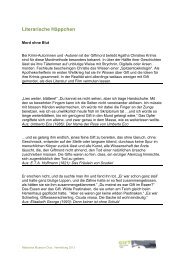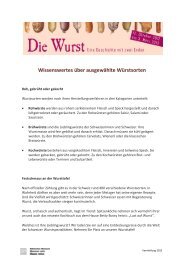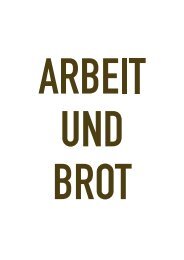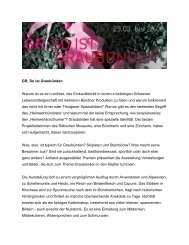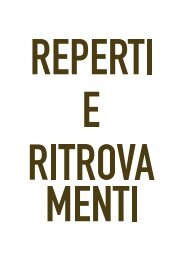Finds and Findings - Raetisches Museum - Kanton Graubünden
Finds and Findings - Raetisches Museum - Kanton Graubünden
Finds and Findings - Raetisches Museum - Kanton Graubünden
Create successful ePaper yourself
Turn your PDF publications into a flip-book with our unique Google optimized e-Paper software.
<strong>Finds</strong><br />
<strong>and</strong> <strong>Findings</strong><br />
2<br />
The term archaeology derives from the Greek<br />
words «archaios» (old) <strong>and</strong> «logos» (teaching).<br />
Which means as much as «lore of antiquity» or<br />
«scientific study of antiquity», always in relation<br />
to the history of man <strong>and</strong> his environment.<br />
Originally archaeology was concerned with nonliterate<br />
or low-grade literate epochs, i.e. with<br />
prehistory <strong>and</strong> early history (Roman epoch). This<br />
insofar as they can be uncovered by excavation,<br />
meaning the decoding of archaeological findings.<br />
This can include entire settlements, also foundation-walls<br />
of houses, burial grounds <strong>and</strong> pits.<br />
Other remains of human activity are for example<br />
ritual sites, hoard finds <strong>and</strong> slag disposal sites,<br />
also finds such as stone tools, metal objects,<br />
pottery, bone artefacts or remains of bones.<br />
Task <strong>and</strong> aim of archaeology is to excavate, document,<br />
<strong>and</strong> to interpret these findings <strong>and</strong> finds as<br />
precisely as possible. They lead to insights into<br />
the history of man <strong>and</strong> his natural environment,<br />
that is to historical conclusions.<br />
At a later time archaeological methods were also<br />
used for the historical epochs. This includes<br />
archaeology of the Middle Ages, castle research,<br />
3
archaeology of churches, the investigation of<br />
town centres <strong>and</strong> even industrial archaeology.<br />
The latter also deals with modern topics such<br />
as mines, mine shafts, furnaces, limekilns,<br />
ceramics <strong>and</strong> glass manufacturing, as well as<br />
various trade aspects. This branch of science<br />
reaches in part into the 20th century.<br />
Today archaeology is a modern science, which<br />
works closely together with the natural sciences.<br />
These include botany, zoology, anthropology,<br />
climatology, geology, dendrochronology, chemistry<br />
<strong>and</strong> physics (C-14-dating).<br />
Archaeology in <strong>Graubünden</strong> There were people<br />
in <strong>Graubünden</strong> who were interested in archaeology<br />
as early as the 16th century. Ulrich Campell,<br />
for example, mentioned the columns <strong>and</strong> cart<br />
tracks on the Julier Pass around 1570. There is<br />
evidence of archaeological collecting in the<br />
early 19th century in the Roman Welschdörfli in<br />
Chur. 1869 the «Historisch-Antiquarische Gesellschaft»<br />
(Historical <strong>and</strong> Antiquarian Society)<br />
<strong>and</strong> 1872 the Rätisches <strong>Museum</strong> were founded.<br />
In 1903 the «Urgeschichte <strong>Graubünden</strong>s mit<br />
Einschluss der Römerzeit» (Prehistory of<br />
<strong>Graubünden</strong> including the Roman Period) was<br />
published.<br />
A first archaeological dig took place in 1902 in<br />
the Custorei of Chur (today Stadthallenplatz).<br />
Further excavations were carried out in 1930–50<br />
under the direction of the forester Walo Burkart.<br />
Names such as Hans Conrad, Walter Sulser <strong>and</strong><br />
Benedikt Frei also belong to this period.<br />
After a position as conservator was created at<br />
the Rätische <strong>Museum</strong> in 1960, emergency<br />
excavations could also be carried out. With the<br />
founding of the office for archaeology in the<br />
year 1967 archaeological activity with extensive<br />
excavations <strong>and</strong> numerous publications<br />
increased greatly.<br />
4 5
stone age<br />
600000–2200 B. C.<br />
6<br />
The Stone Age is the longest period in the history of<br />
mankind. In the area of Switzerl<strong>and</strong> its beginnings<br />
still remain largely in the dark.<br />
Old Stone Age (Palaeolithic) During the Old Stone<br />
Age the Alpine valleys were covered by thick ice<br />
masses. Therefore Palaeolithic sites or finds can<br />
hardly be expected in <strong>Graubünden</strong>. Conceivable are<br />
only finds of cave-bear hunters in caves or below<br />
rock shelters at the edge or above the glaciers. Such<br />
was the case in the «Drachenloch» (Dragon’s Cave)<br />
above Vättis SG at 2450 m or the Apollohöhle above<br />
St.Antönien-Partun at 2300 m. Very simple stone <strong>and</strong><br />
bone artefacts were discovered there, partly also<br />
hearth remains.<br />
Between the 14th <strong>and</strong> 12th millennium the Rheintal<br />
glaciers retreated. After that, a first vegetation<br />
established itself in the Rheintal of Chur. Game<br />
animals advanced from the north into the Alpine<br />
Rhine valley. And during the summer months hunter<br />
groups followed the traces of the wild game. In winter<br />
these groups probably dwelt in the region of the<br />
Vorarlberg (radiolarite from the Grosses Walsertal<br />
<strong>and</strong> silex from Bavaria).<br />
Radiolarite, silex, <strong>and</strong> rock-crystal artefacts from<br />
Chur-Marsöl are from the late phase of the Old Stone<br />
Age. They date back from the time between 11000<br />
<strong>and</strong> 9500 B.C.<br />
7
Middle Stone Age (Mesolithic) That only very few<br />
discovery sites are known in <strong>Graubünden</strong> is also true<br />
of the Mesolithic. It is significant that the Mesolithic-<br />
Neolithic hunter resting-place of Mesocco-Tec Nev<br />
was 8 m deep under the present turf. It came to light<br />
only thanks to the construction of the motorway.<br />
Countless worked flint artefacts <strong>and</strong> towards 4000<br />
flint <strong>and</strong> rock crystal chips were found on this site.<br />
They date back to the early <strong>and</strong> late Mesolithic. Some<br />
early Neolithic pottery <strong>and</strong> flint material was also<br />
recovered.<br />
Mesolithic settlements <strong>and</strong> resting places situated at<br />
valley bottoms now probably lie deeply hidden under<br />
rock-fall <strong>and</strong> l<strong>and</strong>slide material. Or else the activity<br />
of the rivers has definitely destroyed them in the<br />
course of thous<strong>and</strong>s of years.<br />
However, today resting places of hunters are increasingly<br />
being found in the high mountains. For instance<br />
on the Pian dei Cavalli (Val San Giacomo, Italy, 2200m)<br />
situated not far from the Mesolcina. Other wellknown<br />
examples are Plan Canin in the Forno valley<br />
(south of Maloja, 1990m) or in the area of the Lai<br />
da Rims (Val Müstair, 2400 m).<br />
New Stone Age (Neolithic) Today a total of nine<br />
Neolithic settlements are known in <strong>Graubünden</strong>:<br />
Chur-Areal Zindel <strong>and</strong> Ackermann, Untervaz-<br />
Haselboden <strong>and</strong> Haselbodenkopf, Zizers-Friedau,<br />
Tamins-Crestis, Cazis-Petrushügel, Mesocco-Tec<br />
Nev <strong>and</strong> Castaneda-Pian del Remit. These are<br />
without exception smaller settlements, which probably<br />
hardly lasted for more than 100 to 150 years.<br />
Whereas the one or the other of these settlements<br />
date back to an earlier up to a more developed Neolithic<br />
(5th /4th millennium for Zizers, Chur, Mesocco),<br />
the others belong to a rather later phase of the<br />
New Stone Age (3rd millennium).<br />
Of interest is the evidence of an early plough agriculture<br />
in Chur <strong>and</strong> Castaneda. Remarkable is also<br />
the circumstance that these settlements are concentrated<br />
on lower lying transit valleys (Rheintal,<br />
Domleschg <strong>and</strong> Mesolcina). A Neolithic resting place<br />
is also evident in Zernez-Ova Spin. Single Neolithic<br />
finds in the mountains or in higher valleys are<br />
numerous, such as stone axes, silex <strong>and</strong> rock crystal<br />
devices. They are probably proof of hunters or<br />
shepherds rather than of settlements.<br />
8 9
Bronze age<br />
2200–800 B. C.<br />
10<br />
After devices made of copper had already made their<br />
appearance in the late phase of the New Stone Age,<br />
tools <strong>and</strong> weapons were now newly manufactured of<br />
bronze. (Bronze is a copper-tin alloy).<br />
With the Early Bronze Age an intensive new settlement<br />
of the Alpine region of <strong>Graubünden</strong> occurred. In<br />
place of the sparse New Stone Age dwellings came<br />
fifty to sixty longer lasting settlements. They could<br />
now be found not only in the lower valleys but also in<br />
high Alpine valleys (Lugnez, Oberhalbstein, Engadin).<br />
These new settlements may probably be due to the<br />
discovery of copper ores on <strong>Graubünden</strong> soil. The<br />
new processing technology led to new activities.<br />
These included copper prospecting, mining, copper<br />
smelting, bronze casting, etc. This is likely to have led<br />
to a more intensified trade over the Alpine passes<br />
<strong>and</strong> ultimately also to certain social changes.<br />
The inhabitants of Bronze Age villages were farmers.<br />
They subsisted on agriculture (wheat, einkorn wheat,<br />
emmer wheat, spelt, barley, etc.) <strong>and</strong> livestock<br />
breeding. Hunting played only a very secondary role.<br />
In the Early <strong>and</strong> Middle Bronze Age <strong>and</strong> partly still in<br />
the Late Bronze Age, based on special forms in ceramics,<br />
a self-contained culture manifested itself on<br />
<strong>Graubünden</strong> soil. Originally it was called «Crestaulta-<br />
Culture», today it is known as «Inner Alpine Bronze<br />
11
Age Culture». It clearly differs from the southern<br />
<strong>and</strong> northern Alpine cultures.<br />
During the Late Bronze Age (13th–9th century B.C.)<br />
this «Inner Alpine Bronze Age Culture» was obviously<br />
displaced. During this time new cultures penetrated<br />
the Alpine region of <strong>Graubünden</strong>. They led to a<br />
cultural trisection, which can still be shown very<br />
nicely in the Iron Age.<br />
Settlements As a rule Bronze Age settlements were<br />
on hillcrests, on prominent rock b<strong>and</strong>s <strong>and</strong> slope<br />
terraces, which were easy to defend. Settlements at<br />
the bottom of valleys do not seem to have appeared<br />
until the Late Bronze Age. In Savognin-Padnal the<br />
settlement was situated in a natural dell, which was<br />
2 to 3 m deep, in Cazis-Cresta even in a 5 to 6 m deep<br />
rock crevice. In Falera-Muota the settlement was<br />
between mighty boulders. It was fortified by a<br />
surrounding wall. This suggests that the first settlers<br />
felt a great need for protection.<br />
In well-excavated settlements the post <strong>and</strong> beam<br />
<strong>and</strong> log constructions with hearths or even entire<br />
settlements can be construed. The cisterns of<br />
Savognin-Padnal <strong>and</strong> the spring water catchment of<br />
St. Moritz are testimony to a highly developed woodconstruction<br />
technique. As a rule residential buildings<br />
were built in larch wood. Spruce served mainly<br />
as firewood. The settlements partly survived several<br />
hundred or even more than a thous<strong>and</strong> years. In<br />
smaller settlements 20–30 people lived, in larger<br />
ones 50–100.<br />
Burial <strong>Finds</strong> Few Bronze Age burial finds are known<br />
from the Alpine region of <strong>Graubünden</strong>. In Donat-Surses<br />
six stone chest-graves with inhumations were discovered<br />
in 1926 <strong>and</strong> 1961. The burial objects date back<br />
to the late Early Bronze Age (17th/16th century B.C.).<br />
However, the famous vaulted grave of Donat («Kuppelgrab<br />
von Donat») is probably a medieval vaulted cellar<br />
(Crot), which disturbed an Early Bronze Age grave.<br />
There are further Early Bronze Age inhumations<br />
without burial objects from Laax-Salums as well.<br />
Of greatest importance are eleven cremation burials<br />
from Lumbrein-Surin-Cresta Petschna. They are<br />
all women’s graves equipped with rich jewellery gifts,<br />
which obviously belong to the settlement on the<br />
Crestaulta. They date back to the early Middle Bronze<br />
Age (16th /beginning 15th century) <strong>and</strong> are influenced<br />
by the burial mound culture.<br />
From the Late Bronze Age there is an urnfieldgrave<br />
of Fläsch-Answiesen – unfortunately severely<br />
damaged – <strong>and</strong> a female burial of Domat/Ems. The<br />
latter contained a bow fibula of southern origin,<br />
earrings <strong>and</strong> some pottery.<br />
12 13
<strong>Finds</strong> in Mountains <strong>and</strong> Waters Single finds, which<br />
were discovered in the mountains as well as on<br />
mountain passes, are numerous. Hunters or herdsmen<br />
could have lost these. However, these finds<br />
could also be evidence of Bronze Age Alpine farming.<br />
In individual cases they might be votive offerings<br />
to a mountain deity.<br />
For example swords, lances <strong>and</strong> other objects are<br />
found just as often in waters, in rivers, lakes or also<br />
in or around springs. Whether these are lost objects<br />
or votive offerings to a water deity is unclear. Two<br />
bronze axes near a spring above Rueun or several<br />
sword finds, a dagger, <strong>and</strong> a pin in the spring-water<br />
tapping of St.Moritz-Bad could have been votive<br />
offerings to a spring deity.<br />
The spring-water tapping system of St.Moritz is a<br />
highly interesting wooden structure. It consists of a<br />
log chest <strong>and</strong> a plank chest; inside there are two<br />
vertical pipes as well as a climbing device. Everything<br />
is made of larch wood <strong>and</strong> dates back to the middle<br />
of the 15th century B.C.<br />
Jewellery In the Bronze Age bronze pins were very<br />
often worn as garment fasteners. Coarse linen<br />
fabrics were fastened with these. After the Late Bronze<br />
Age fibulae replaced the bronze pins. Additional<br />
ornamental objects were bracelets <strong>and</strong> finger rings,<br />
necklaces with amber <strong>and</strong> small bronze roulettes or<br />
thorn discs, buttons made of bone <strong>and</strong> bronze, which<br />
were probably sewn onto fabric. The intended use of<br />
deer horn roses is uncertain. The boar’s tusk lamella<br />
may have served as a wrist-guards for archers.<br />
The most significant object found is the beautifully<br />
decorated disc-headed pin from Falera-Muota. It is<br />
85 cm long. Because of its size it is unlikely that it<br />
was worn by a woman. It could have been used as a<br />
cult or prestige object, for example to decorate a<br />
wooden statue.<br />
Bronze <strong>and</strong> amber jewellery was a privilege of the<br />
upper class. Jewellery pieces as grave goods<br />
were supposed to ensure the social position of the<br />
deceased in the hereafter. There were certainly also<br />
ornaments made of simple materials, which however<br />
have not survived.<br />
14 15
iron age<br />
800 –15 B. C.<br />
16<br />
The Iron Age is divided into an older phase (Hallstatt<br />
period) <strong>and</strong> a younger phase (La Tène period). The<br />
raw material iron was first put to use during the Iron<br />
Age. Iron artefacts rapidly replaced tools <strong>and</strong><br />
weapons of bronze. Iron has great advantages: It is<br />
robust <strong>and</strong> elastic, <strong>and</strong> is much more common in the<br />
Alpine region than copper. However, bronze was<br />
still used for jewellery. Iron processing required considerable<br />
technical know-how. Specialists such as<br />
miners, ore masters, blacksmiths were necessary.<br />
Smelting furnaces <strong>and</strong> smithies had to be built.<br />
Trade across the Alpine passes continued to play a<br />
major role. Writing appeared for the first time, in the<br />
Late Iron Age also monetary economy.<br />
The settlement structure of the Iron Age largely<br />
corresponds to that of the Bronze Age. Since the Late<br />
Bronze Age, <strong>Graubünden</strong> – probably due to pressure<br />
from outside – became subject to a cultural trisection.<br />
This is clearly noticeable during the entire Iron Age.<br />
17
Raetians In southeastern <strong>Graubünden</strong> (Unterengadin,<br />
Münstertal) there is evidence during the Late<br />
Bronze Age <strong>and</strong> Earlier Iron Age of the Laugen-<br />
Melaun culture. Its culture-defining feature is the<br />
Laugen-Melaun-Jug. It can be found in the Trentino,<br />
in the South Tyrol <strong>and</strong> in the Unterengadin but only<br />
sporadically in the Alpine Rhine valley. Typical settlements<br />
are Ramosch-Mottata, Scuol-Munt Baselgia<br />
<strong>and</strong> Ardez-Suotchasté. In Scuol-Motta Sfondraz <strong>and</strong><br />
Zernez-Brail-Funtanatschas there are presumably<br />
burnt-offering places on mighty riprap revetments,<br />
which are considered to be cult sites.<br />
The Laugen-Melaun culture is replaced by the Fritzens-<br />
Sanzeno culture, whose features are small bowls<br />
<strong>and</strong> jugs. In Scuol-Russonch there is a characteristic<br />
burnt-offering place. This includes fireplaces <strong>and</strong><br />
calcinated – that is severely burnt – animal bones. As<br />
far as dissemination of the Fritzens-Sanzeno culture<br />
goes, the core area is again the Trentino, the South<br />
<strong>and</strong> North Tyrol <strong>and</strong> the Unterengadin. The bearers of<br />
the Laugen-Melaun as well as the Fritzens-Sanzeno<br />
culture are today identified with the historical Raetians.<br />
Celto-Raetians <strong>and</strong> Celts As of the Late Bronze Age<br />
the urn field culture becomes visible in north <strong>and</strong><br />
middle <strong>Graubünden</strong> (Chur-Karlihof, Vella-Pleif, etc.). It<br />
clearly advances from the north. In north <strong>Graubünden</strong><br />
it is overlaid by an element of the Laugen-Melaun<br />
culture (Celto-Raetian mixed culture). As of the Earlier<br />
Iron Age marked influences of the Hallstatt culture<br />
become apparent (Felsberg-Felixwingert, painted<br />
pottery from Tamins). In the Later Iron Age with the<br />
Tamins <strong>and</strong> Schneller pottery (Alpine Rhine Valley<br />
groups), the grooved pottery (Kammstrich-Keramik)<br />
<strong>and</strong> later the graphite-clay pottery the Celtic northern<br />
influence remains clearly visible.<br />
The Laugen-Melaun elements of the Late Bronze Age,<br />
which reached northern <strong>Graubünden</strong> over the Vorarlberg,<br />
still recall the Raetian culture. Undoubtedly<br />
the Celtic element had been predominant since the<br />
Iron Age. For northern <strong>Graubünden</strong> corresponding<br />
settlement-remains exist (Chur-Welschdörfli, Fläsch,<br />
Lantsch/Lenz, Suraua, Trun-Darvella, etc.). The<br />
same is true of grave finds (Tamins urn grave field,<br />
Trun-Darvella, etc.). The Raetian element completely<br />
disappears at this time.<br />
18 19
Lepontians In southwestern <strong>Graubünden</strong> (Mesolcina,<br />
Calancatal, Bergell) there is growing evidence since<br />
the Late Bronze Age of a Tessin-Lombardian Canegrate<br />
culture. In the Earlier <strong>and</strong> also in the Later Iron Age<br />
the southwestern cultural area of <strong>Graubünden</strong> clearly<br />
belongs to the Golasecca culture. This is above all<br />
characterised by a great wealth of finds in its grave<br />
inventories. Thus, in the burial ground of Mesocco-<br />
Coop there are inhumations <strong>and</strong> cremations with a<br />
wealth of fibula jewellery. In the inhumations of<br />
Castaneda <strong>and</strong> Cama, which are rich in finds, there<br />
are again lots of fibula ornaments, pendants, earrings,<br />
amber necklaces, Situlae (buckets), beaked flagons,<br />
iron swords, jugs, beakers, etc.<br />
Since there are no raw materials in the Misox, the<br />
question arises where this wealth came from. It is<br />
assumed that during the Iron Age the valley played an<br />
intermediary role in trade across the Alpine passes<br />
between the Etruscan <strong>and</strong> the northern Alpine area.<br />
Compared to the grave finds the settlement finds turn<br />
out to be rather modest. The early Roman writers<br />
address the bearers of this culture as Lepontians.<br />
Trade in Prehistoric <strong>and</strong> Roman Times At the time<br />
of the New Stone Age there are already indications of<br />
some bartering. Thus flint utensils from the French<br />
Jura, from Lägeren ZH <strong>and</strong> also from the Monti Lessini<br />
(Trentino) appeared.<br />
During the Bronze Age there was a flourishing trade<br />
across the Alpine passes (bronze production, tin trade,<br />
amber, ceramic vessels, etc.).<br />
During the Iron Age trade between the Etruscan region<br />
<strong>and</strong> north of the Alps was intensified. In northern<br />
<strong>Graubünden</strong> forms of jewellery from south of the<br />
Alps appeared. For the first time there are coin finds.<br />
Salt was imported from southern Germany.<br />
In Roman times there is an intensive movement of<br />
goods over the Julier pass. Terra Sigillata vessels<br />
reached <strong>Graubünden</strong>. Lavez (soapstone) vessels from<br />
Upper Italy, the Bergell <strong>and</strong> Misox were traded via<br />
Chur to Bregenz <strong>and</strong> Augsburg. Olive oil from Spain,<br />
wine from Italy, tropical fruits, oysters, fabrics <strong>and</strong><br />
spices were imported. Livestock, grain, honey <strong>and</strong><br />
wax, pitch, rock crystal, Alpine cheese <strong>and</strong> woollen<br />
coats went south. The road system was probably well<br />
developed from the middle of the first century A.D.<br />
onward.<br />
20 21
oman age<br />
15 B.C.–400 A.D.<br />
22<br />
Around 16/15 B.C. Roman troops under Emperor<br />
Augustus advanced north. The comm<strong>and</strong>ers Tiberius<br />
<strong>and</strong> Drusus starting from Gaul <strong>and</strong> the Trentino led<br />
the pincer operation. A third army unit probably advanced<br />
from Como over the Septimer Pass through<br />
the Oberhalbstein <strong>and</strong> the Alpine Rhine Valley. Militaria<br />
finds especially sling leads on the Septimer <strong>and</strong> in<br />
the Crap Ses area attest to this. In a summer lightning<br />
operation of 4 months the Alpine region from the Wallis<br />
to Bavaria was conquered. Purpose of the campaign<br />
was no doubt the safeguarding of the Alpine passes<br />
<strong>and</strong> establishment of footholds north of the Alps.<br />
A province Raetia with the capital Augsburg was founded<br />
only towards the middle of the first century A.D.<br />
The province was divided around 300 into Raetia<br />
prima (no doubt with the principal town Chur) <strong>and</strong> the<br />
Raetia secunda (capital Augsburg).<br />
The Roman conquest brought extensive cultural<br />
changes. Large stone buildings in lime mortar technique<br />
now replaced the former wooden structures.<br />
The stone houses now often had wall paintings,<br />
hypocaust or duct heating systems <strong>and</strong> were roofed<br />
with shingles or even tiles. Baths, theatres <strong>and</strong> other<br />
public buildings were constructed. The local population<br />
also bought imported, richly decorated terra<br />
sigillata tableware <strong>and</strong> southern import goods such<br />
as tropical fruits, olive oil, wine <strong>and</strong> more besides.<br />
23
It wasn’t long before individual locals mastered the<br />
Latin language <strong>and</strong> script. Roman monetary economy<br />
was introduced, as was within a relatively short<br />
time the worship of Roman deities. In the course of<br />
several centuries Latin displaced the local languages<br />
(the Celtic <strong>and</strong> the Rhaetian). These only lived on in<br />
overlaid substrata. A kind of «Vulgar Latin» or<br />
«Raeto Latin» evolved, out of which ultimately the<br />
Old Romansch (Altromanisch) <strong>and</strong> Romansch<br />
(Rätoromanisch) developed.<br />
Chur in Roman Times There is an inscription from<br />
the Welschdörfli in Chur, which is dedicated to Lucius<br />
Caesar, a high Roman official. It suggests that Chur<br />
was already an administrative centre in early Roman<br />
times. The first residential buildings were probably<br />
still built of wood. From the middle of the 1st century<br />
A.D. on, a busy building activity set in with stone buildings.<br />
Numerous houses with Hypocaust <strong>and</strong> ductedair<br />
heating were constructed. In the area Ackermann<br />
there was a hostel with murals <strong>and</strong> sleeping facilities.<br />
In the area of the «Stadthallenplatz» (municipal<br />
hall square) there was a large thermal complex,<br />
probably also the market <strong>and</strong> a shrine.<br />
After the Diocletian reform of the Empire around<br />
300 A.D., Chur probably became the capital of the<br />
Province Raetia prima. At least since the 4th century<br />
there was a Roman settlement on the Hof in Chur,<br />
which was protected by castle-like walls. There is<br />
evidence that an Episcopal see <strong>and</strong> a grave church on<br />
the Hof had existed since the 5th century. At this time<br />
there were still some residential buildings as well as<br />
an early Christian church complex with priests’ bench<br />
in the Welschdörfli.<br />
24 25
Roman Settlements <strong>and</strong> Sacred Sites Beside the<br />
Roman Curia there were numerous smaller settlements.<br />
There were way stations such as Mutatio of<br />
Riom or the settlement of Mon-Crest’Ota, both on the<br />
traversable Julier road. Important is also the late<br />
Roman customs station of Bondo-Murus/Castelmur.<br />
Furthermore there were several fortified castle-like<br />
settlements of the late Roman-early medieval<br />
time period. Belonging to these were for example<br />
Tiefencastel-Kirchhügel, Castiel-Carschlingg, Casti,<br />
Vicosoprano-Caslac, <strong>and</strong> probably also Maladers-<br />
Tummihügel West <strong>and</strong> Sagogn-Schiedberg.<br />
Roman sacred sites are for example the one on the<br />
Julier, the cave sanctuary of Zillis, the burnt-offering<br />
place of Fläsch-St.Luzisteig. Additional find complexes<br />
<strong>and</strong> grave finds suggesting settlements come<br />
from Andeer, Cazis-Niederrealta, Sevgein, Tamins,<br />
Trimmis or from the early Roman military camp on<br />
the Septimer pass. Significant grave finds <strong>and</strong> burial<br />
grounds are known from Bonaduz-Valbeuna,<br />
Roveredo-Tre Pilastri, Cama, Sta.Maria in Calanca<br />
<strong>and</strong> from the ravine of Calfreisen. They all point<br />
to a surprising settlement density in Roman times.<br />
26 27
early middle ages<br />
400 – 800 A. D.<br />
28<br />
During the course of the 5th century Roman troops<br />
partly withdrew from Raetia. The Raetian Alpine region<br />
came under Ostrogothic rule as a bulwark against the<br />
Germanic tribes. After the death of Theodoric (527)<br />
Raetia prima, or rather the Diocese Chur, came more<br />
<strong>and</strong> more under Frankish influence. In the 4th/5th<br />
century Raetia prima was Christianised. In Chur a<br />
bishopric is documented as of 451. From the 6th century<br />
on the dynasty of the Zaccons <strong>and</strong> the local Victorids<br />
held the ecclesiastical <strong>and</strong> secular power in Churraetia.<br />
Under Charlemagne Churraetien lost its political<br />
independence around 773/74. It was definitively<br />
integrated into the Frankish Empire.<br />
Relatively few settlements from the Early Middle<br />
Ages have been studied up until now. Most of them<br />
developed from late Roman settlements <strong>and</strong> castle<br />
grounds, for example Castiel-Carschlingg, Maladers-<br />
Tummihügel, Schiers-Chrea, Tiefencastel, Riom-<br />
Cadra or Zernez. This is because these settlements<br />
from the Early Middle Ages often lie under today’s<br />
villages <strong>and</strong> as the constructions are out of wood they<br />
cannot be determined easily. Only church buildings,<br />
monasteries <strong>and</strong> stately buildings (Royal Court Zizers)<br />
were still built in stone <strong>and</strong> bonding mortar.<br />
However, the numerous Early Middle Age churches<br />
of <strong>Graubünden</strong> are proof of a considerable density<br />
of settlements.<br />
29
Furthermore there are many Early Middle Age graves<br />
<strong>and</strong> burial sites. However, as a rule they hold only<br />
modest grave goods or none at all. One of these is,<br />
for example, the late Roman-Early Middle Age burial<br />
ground of Bonaduz-Valbeuna with over 700 burials,<br />
the graveyards of Chur-St.Stephan, or Schiers-<br />
Pfarrhausgarten. Up until the 7th/8th century heathen<br />
cult sites are still in evidence in the Alpine region of<br />
<strong>Graubünden</strong>, for example, in the cave of Zillis.<br />
In <strong>Graubünden</strong> the ultimate Romanisation of the<br />
language probably took place in the Early Middle Ages.<br />
Impressum<br />
Neue Dauerausstellung «Funde und Befunde»<br />
im Untergeschoss.<br />
Konzipiert und produziert von den Mitarbeiterinnen<br />
und Mitarbeitern des Rätischen <strong>Museum</strong>s, in<br />
Zusammenarbeit mit den ausführenden Firmen<br />
Fachberatung und Texte:<br />
Archäologischer Dienst <strong>Graubünden</strong>,<br />
Jürg Rageth<br />
Gestaltung der Ausstellung:<br />
gasser, derungs Innenarchitekturen<br />
Bauliche Massnahmen:<br />
Hochbauamt <strong>Graubünden</strong><br />
Rudolf Fontana & Partner AG<br />
Übersetzungen:<br />
St<strong>and</strong>eskanzlei <strong>Graubünden</strong><br />
Jane Gillespie-Casparis<br />
Die Finanzierung erfolgte durch Verwaltungskredite<br />
des <strong>Kanton</strong>s <strong>Graubünden</strong>, aus Mitteln der Stiftung<br />
Rätisches <strong>Museum</strong> sowie des Fonds der Stadt Chur<br />
innerhalb dieser Stiftung.<br />
Das Rätische <strong>Museum</strong> dankt für Schenkungen,<br />
Leihgaben, Auskünfte und vielfältige Unterstützung<br />
bei der Realisierung dieser Ausstellung.<br />
2011 © Rätisches <strong>Museum</strong>, Chur<br />
30 31



